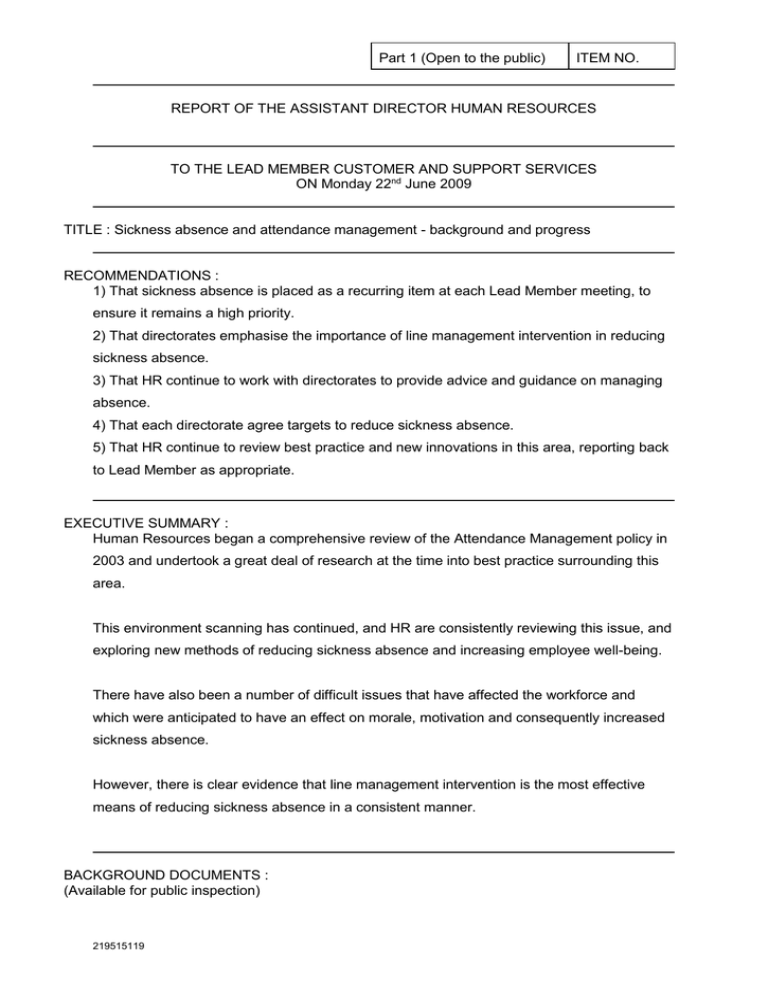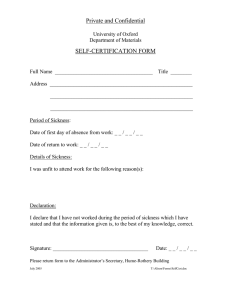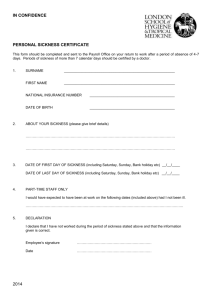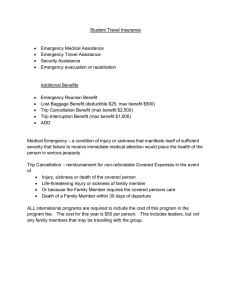Part 1 (Open to the public) ITEM NO.
advertisement

Part 1 (Open to the public) ITEM NO. REPORT OF THE ASSISTANT DIRECTOR HUMAN RESOURCES TO THE LEAD MEMBER CUSTOMER AND SUPPORT SERVICES ON Monday 22nd June 2009 TITLE : Sickness absence and attendance management - background and progress RECOMMENDATIONS : 1) That sickness absence is placed as a recurring item at each Lead Member meeting, to ensure it remains a high priority. 2) That directorates emphasise the importance of line management intervention in reducing sickness absence. 3) That HR continue to work with directorates to provide advice and guidance on managing absence. 4) That each directorate agree targets to reduce sickness absence. 5) That HR continue to review best practice and new innovations in this area, reporting back to Lead Member as appropriate. EXECUTIVE SUMMARY : Human Resources began a comprehensive review of the Attendance Management policy in 2003 and undertook a great deal of research at the time into best practice surrounding this area. This environment scanning has continued, and HR are consistently reviewing this issue, and exploring new methods of reducing sickness absence and increasing employee well-being. There have also been a number of difficult issues that have affected the workforce and which were anticipated to have an effect on morale, motivation and consequently increased sickness absence. However, there is clear evidence that line management intervention is the most effective means of reducing sickness absence in a consistent manner. BACKGROUND DOCUMENTS : (Available for public inspection) 219515119 ASSESSMENT OF RISK: N/A SOURCE OF FUNDING: N/A COMMENTS OF THE STRATEGIC DIRECTOR OF CUSTOMER AND SUPPORT SERVICES (or his representative): 1. LEGAL IMPLICATIONS Provided by :N/A 2. FINANCIAL IMPLICATIONS Provided by :N/A 3. ICT STEERING GROUP IMPLICATIONS Provided by:N/A PROPERTY (if applicable): HUMAN RESOURCES (if applicable): CONTACT OFFICER : Debbie Brown - Assistant Director Human Resources 793 3523 KEY DECISION : WARD(S) TO WHICH REPORT RELATE(S): Not Applicable KEY COUNCIL POLICIES: Employee Matters; DETAILS (Continued Overleaf) 1. Background 1.1. Human Resources began a comprehensive review of the Attendance Management policy in 2003 and undertook a great deal of research at the time into best practice surrounding this area. 1.2. This environment scanning has continued, and HR are consistently reviewing this issue, and exploring new methods of reducing sickness absence and increasing employee well-being. 219515119 1.3. In a national report by the Audit Commission, there is clear evidence that managing sickness absence effectively is important in improving retention rates and the attractiveness of working in local government. The report makes clear that where councils have seen an improvement in their sickness absence levels, when the management attention drifts elsewhere the trend reverses, and sickness levels increase. 1.4. An IDS Study on Absence Management claimed that organisations deemed to demonstrate best practice in reducing sickness absence exhibit a number of common factors 1. Robust data collection 2. Comprehensive policies and procedures 3. Promote a culture that shows employees the cost of absence and rewards good attendance and/or promotes healthy living/eating initiatives 2. Robust Data Collection 2.1. Accurate and meaningful management information on absence broken down by area, causes and categories is essential in enabling swift and responsive action to be taken. A review of data collection showed that there were gaps and inaccuracies in the data held and a significant proportion of the sickness absence was being recorded as “other”. 2.2. This situation was addressed with a new, simplified system for recording sickness absence onto SAP via an online form. The revised arrangements provided access for line managers to update SAP at the point of source. 2.3. There is now one standard form for recording information from the initial notification of an employee’s sickness absence and the point at which the employee returns to work. This is an electronic form available on the intranet which enables SAP to be immediately updated. 2.4. Implementation of this system started with a pilot in two areas, and was then extended to the remaining directorates, with schools coming on board in early 2008. 219515119 2.5. Throughout this process, the form has been refined and amended, so that line managers can now see the last six months absence history of any employee, along with details of trigger points. 2.6. The reasons for absence were greatly reduced and brought into line with the categories used by the national Employers Organisation to enable comparative analysis. There is no longer an option to record sickness as “other”. 2.7. HR routinely provides detailed and high level sickness absence data on a quarterly basis, which is published on the intranet. This information is also reported at the quarterly performance meetings attended by Lead Members, the Chief Executive and the Leader. This data includes summary information by directorate, by reasons for absence, an overall city council figure and comparisons between directorates using graphical formats and detailed spreadsheets. 2.8. Comparisons are made between the latest version and previous figures to identify any obvious areas of concern that may require further inspection. 2.9. The SAP team also alert managers at all levels with sickness absence reports on a monthly via email so that those staff who have hit the trigger points are alerted to managers. 2.10. The figures are also regularly presented at Customer and Support Services Scrutiny committee, and the committee have invited Strategic Directors to attend and explain how their directorate are tackling absence on a number of occasions. 2.11. The Audit Commission recently reviewed our sickness absence performance indicator. They reviewed the data collected onto SAP via the online absence recording system, how our figures were then calculated and the processes and procedures surrounding this. The result was that they passed this indicator, and were happy that our figures and calculations were accurate and robust. However, there were a number of recommendations for further improvement that they made, one of which related to record keeping. A briefing note was sent to all senior managers to remind them of the importance of accurate record keeping, holding documentary evidence and the ability of third parties to validate this data. 219515119 3. Comprehensive Policies and Procedures 3.1. A review of best practice in terms of policies and procedures was undertaken as part of the review. This included organisations in the public and private sector, and other Local Authorities including our neighbouring Authorities in the Greater Manchester area. 3.2. It was concluded that the City Council policy introduced in 2000 largely represented good practice in that it provides for return to work interviews, has a graduated approach in terms of action taken and involves Occupational Health. However, it was clear that there was scope for improvement in a number of areas. 3.3. The following key improvements were made to the original attendance management policy:- a. Reduction of trigger point for long-term sickness absence from 8 weeks to 4 weeks b. Simplification of trigger points for short-term sickness absence to excess of 7 working days self-certified absence in 6 months or 3 or more absences in 6 months. c. Greater clarity on the importance of maintaining regular contact with employees who are off sick d. Production of management guidelines to accompany the Policy to provide advice on issues such as conducting return to work interviews, dealing with stress related illness etc. 3.4. Salford City Council were short listed for the best absence management strategy award by Pay Magazine in 2006, and subsequently won this award. 3.5. Following our success in achieving ‘Best Absence Management Strategy Award’ from Pay Magazine we were approached by Income Data Services (IDS) and asked if we would be happy to be interviewed as a case study for the publication. We agreed and appeared in the publication in March 2007, and were also contacted by a number of authorities who requested copies of our policy. 3.6. We commissioned an employee communications campaign to highlight the effects that absence had on the authority and to promote health and wellbeing. The key areas that the employee communications campaign focused on over 2007/8 were as follows: 219515119 a. Quarter 1 - Promoting Special Leave Arrangements This focus was on promoting other types of leave available to staff so that they were not inappropriately taking sickness absence instead of carer’s leave etc. b. Quarter 2 - Promoting commitment The information available to us indicated that employees associated with schools generally had less absence per short-term illness than those associated with the Directorates. We felt that this was due to them identifying with a smaller team and feeling as though their contribution was missed when they were absent. The less paid amongst our workforce had a higher absence than those paid more and again we felt that this was about feeling as though your contribution mattered. c. Quarter 3 - Infection prevention We promoted ways for employees to protect themselves from such illnesses as colds and flu over this quarter. d. Quarter 4 - Stress prevention Most days were lost due to stress and depression. The final element of the campaign focused on supporting employees with stress and supporting people who were experiencing symptoms of stress. 3.7. This was primarily a poster and intranet campaign and we also worked with other areas in the authority to co-ordinate health advice provided to employees. 3.8. Internal audit originally assessed the impact of the Attendance Management Policy in 2006 and made a number of recommendations around the implementation of the policy. A Post Implementation Review (PIR) was then undertaken and the results published in 2008 which followed up on any outstanding recommendations. 3.9. The main findings of the PIR were that two significant areas of weakness remained: a. Promptness and evidencing of return to work interviews b. Holding review meetings when short-term absence triggers are hit 3.10. HR continue to work with directorates to raise their performance in this area, and have provided workshops in all directorates to help make sense of the data and identify areas requiring further action. 219515119 4. Culture of Health and Wellbeing 4.1. The importance of promoting a preventative approach to managing sickness absence has been a key feature of the review. With access to more accurate date on the reasons for absence we can identify interventions to address the main causes of absence. 4.2. The free, confidential counselling service available to all employees is of great value for employees experiencing stress related illness. 4.3. There is access to a physiotherapy service for employees presenting with musculoskeletal problems such as back strain etc, and ergonomic workstation assessments can also be arranged. 4.4. Flu jabs have been made available to all City Council employees for a number of years via on-site clinics provided by the PCT. 4.5. City Council employees were also encouraged to take part in the “Watch Your Step” campaign. 4.6. Health MOT’s are being offered and are carried out by qualified nurses on a one to one basis and last 20 minutes each. They include height, weight and Body Mass Index (BMI) measurement and blood pressures, blood sugar and cholesterol checks. Tailored health advice is offered to participants on healthy eating, smoking cessation and physical activity. 4.7. Walk to Work Week is a campaign to raise awareness of the benefits of walking and encourage people to fit more of it into their everyday lives. 4.8. The free NHS Stop Smoking service is available to all Salford City Council employees and offers a number of advantages to help you quit smoking: 4.9. Discussions are taking place with the PCT to identify other opportunities for raising awareness on health issues. 4.10. Rewarding full attendance is also a feature of the work on reward and recognition. It is important that employees understand the cost of sickness absence and that the City Council views reducing sickness absence levels as a priority. 219515119 Rewarding full attendance over for example 1 year, 3 years and 5 years is one way of reinforcing this message. 5. Figures 5.1. In 2004/2005, the average absence figure stood at 14.59 days. By 2005/2006 this figure had fallen to 10.54 days. For 2006/2007 the figure was 10.96 days and 2007/2008 it was 10.80 days. However, the latest year end figure for 2008/2009 has seen a rise to 11.51 days. Directorate 2007/2008 2008/2009 Difference Target 10.5 Target 10.25 Chief Executive 10.59 10.66 0.07 Environment 13.28 12.27 -1.01 Community Health & Social Care 15.22 17.78 2.56 Customer & Support Services 10.83 12.42 1.59 Children’s Services 13.14 13.44 0.3 School Based 7.85 8.21 0.36 HCP 13.34 14.07 0.73 Sustainable Regeneration 6.58 9.62 3.04 Urban Vision 11.35 10.91 -0.44 Salford Council 10.8 11.51 0.71 5.2. The table below shows the average number of days lost due to sickness absence by directorates based on both short term and long term absence for the last two years. 6. Future actions 6.1. We are currently preparing a proposal for Environment and for Community, Health and Social Care to trial a new system of nurse led first contact (Appendix 1). We are taking advice from Procurement as to whether a tender process needs to be instigated. This system is offered by a firm called Diagnostic Health Solutions, and they guarantee that we will see a reduction of at least 10% in the number of days lost, or they will waive their fee. An additional benefit to be found with this service is that the 24 hour phone line can be accessed by an employee at any time for medical advice, not just when phoning in sick, and can also be used to obtain medical advice for family members. We see this as a good benefit to be providing to employees, especially when many other changes are taking place that may not be seen so positively. 219515119 6.2. Occupational Health are currently undergoing a realignment of services, working closely with the workforce agenda, and aiming at preventative measures in partnership with the PCT. 6.3. All our research has identified that line management intervention has consistently been shown to be the most effective way to see a reduction in short-term sickness absence, and we would recommend that sickness absence is a regular item on every Lead Member agenda, to ensure that it remains a high priority for every directorate. 6.4. It is also recommended that each directorate agree specific targets to reduce sickness absence. 7. Conclusion 7.1. The improvements made as a result of this review provided managers with a robust framework to enable sickness absence levels to be reduced. Whilst it is essential to have such a framework in place, there is no doubt that those with people management responsibilities must take an active approach to caring for the health and wellbeing of their staff and using all of the options open to them in reducing sickness absence levels. 7.2. There have also been a number of difficult issues that have affected the workforce and which were anticipated to have an effect on morale, motivation and consequently increased sickness absence. For example, the pay and grading review; jobs and structure changes as a result of Think Efficiency reviews; industrial dispute over the pay award; changes to pension arrangements. This has all taken place against the backdrop of wider unrest caused by the credit crunch. 7.3. Whilst we are not complacent about sickness absence, it should be noted that despite all of the above pressures, there remains a significant level of goodwill amongst the workforce with many officers working above the required 36 hour week at no pay. Appendix 1 DHS proposal June 2009.doc 219515119


